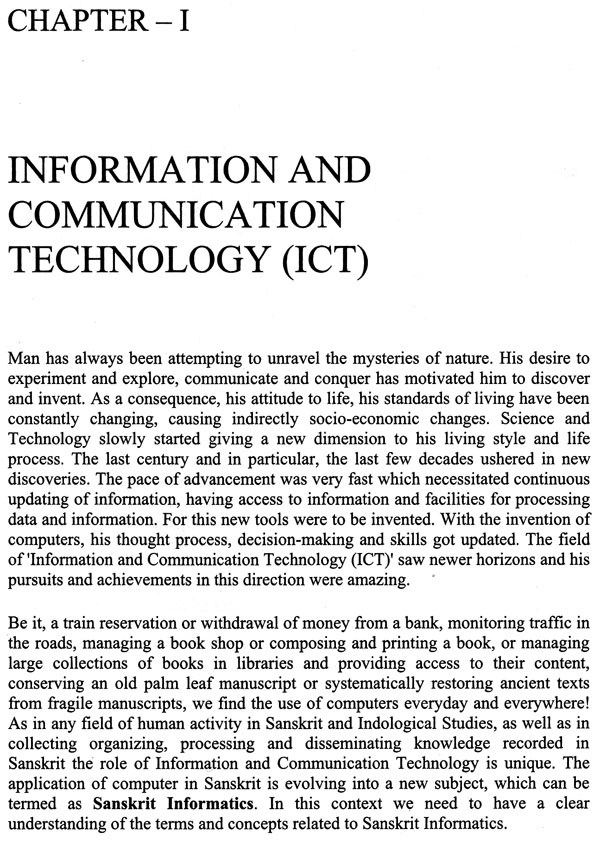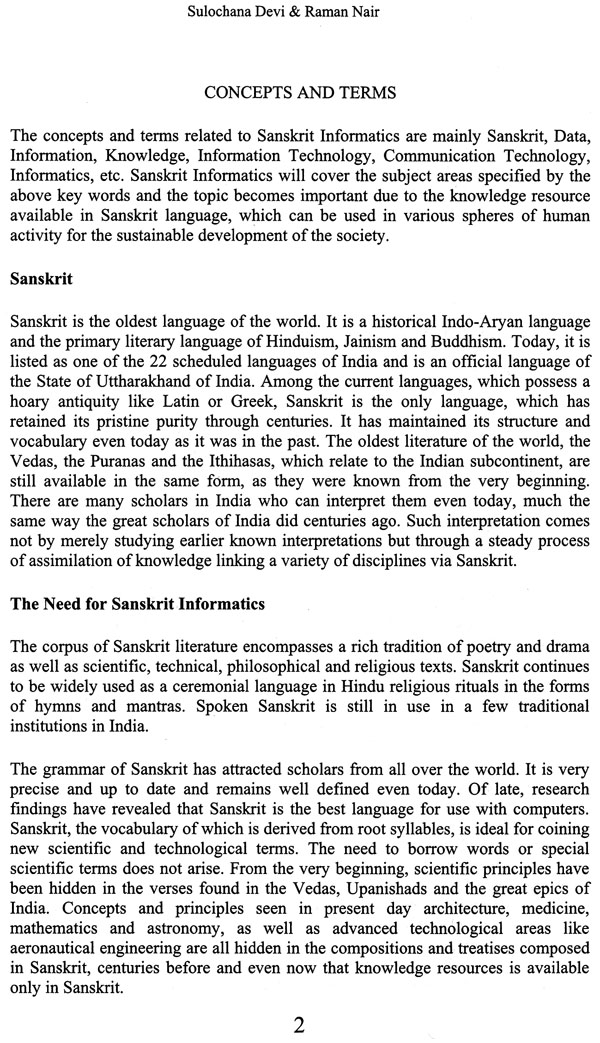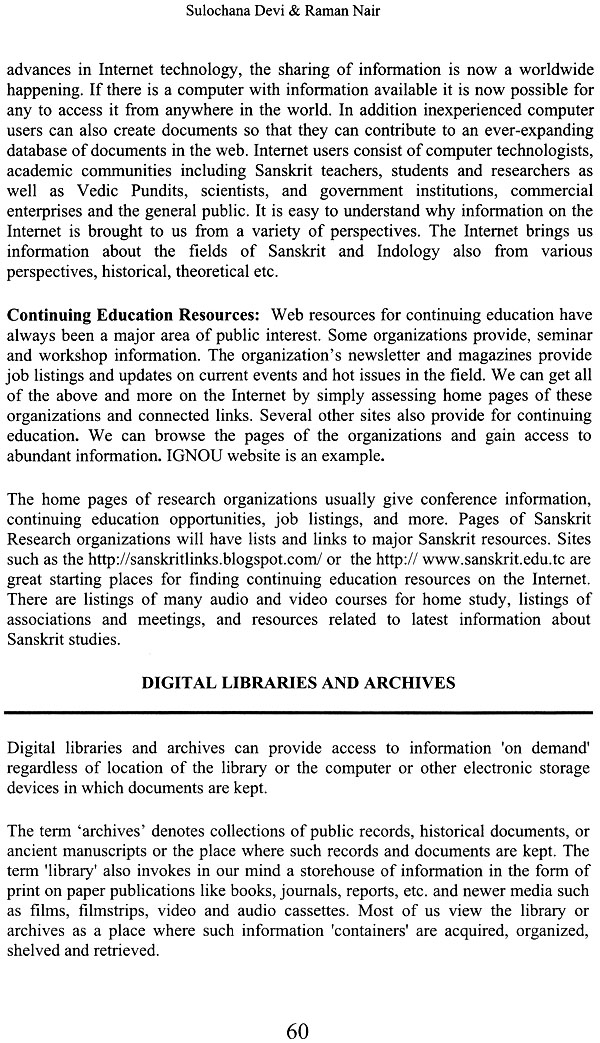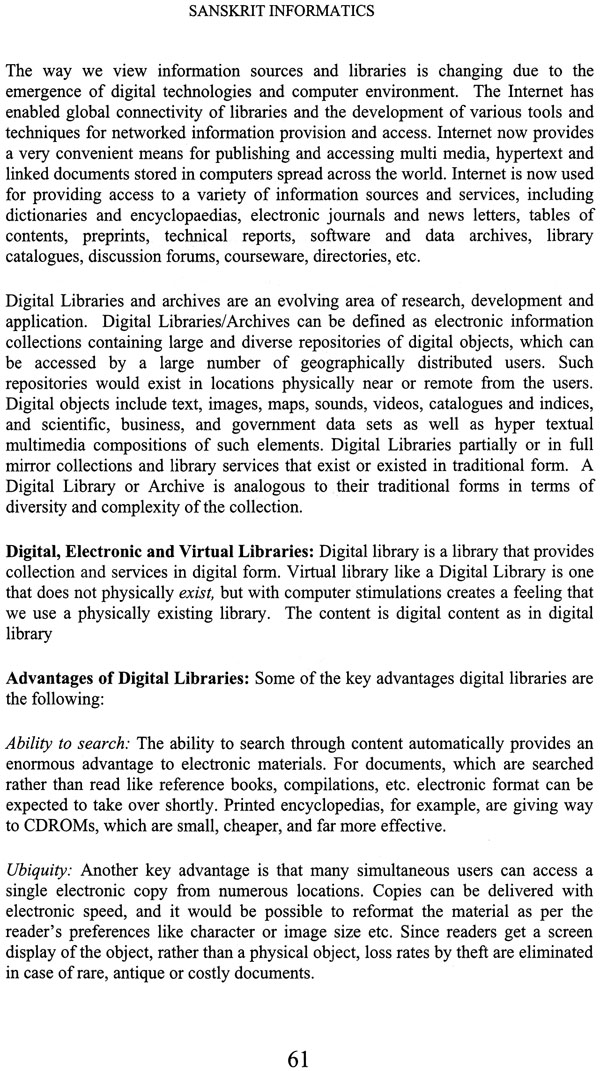
Sanskrit Informatics
Book Specification
| Item Code: | NAP616 |
| Author: | R. Raman Nair and L. Sulochana Devi |
| Publisher: | Center For Informatics Research And Development |
| Language: | English |
| Edition: | 2011 |
| ISBN: | 9788192203003 |
| Pages: | 160 (51 B/W illustrations) |
| Cover: | Hardcover |
| Other Details | 8.5 inch X 5.5 inch |
| Weight | 250 gm |
Book Description
Ict is totally changing the ways of of our life and activities and is a part of day-to-day life. A suitable language for interaction with the machine is now a felt need. Research on machine translation and natural language interfaces have revealed that the structural, grammatical and semanstic properties of Sanskrit make it more suitable than English for computers. This points out the possibility of Sanskrit again becoming a dominant language of the world. This can help both informatics and Sanskrit and can throw open for the benefit of humanlity; the huge ocean of knowledge on different areas like mythology, philosophy, law, religion, science, architecture medicine, chemistry, mathematics, astronomy, aeronautical engineering and the like recorded in Sanskrit remaining unutilized.
Sanskrit Informatics is intended as a study guide for Sanskrit students attending methodology courses on Informatics. It can create an awareness about the available digital resources on Sanskrit and Indology, and introduce the basics of ICT skills for effectively accessing, processing and using such resources.
Information and Communication Technology (ICT) is causing revolutionary changes in the ways of our trade economy,occupation, development, education,research, culture and leisure. It has brought in a new style of existence, and solution for numerous problems of the society. Adverse effect of this technology also need attention. Now society has become dependent on ICT for each and every aspect of life. Application of ICT in various sphere of activity has resulted in the specializations like Medical Informatics, Agricultural Informatics and Sanskrit Informatics. Earlier, only scientists have to communicate have to communicate with the machine frequently. As ICT has become essential for day –to –day life now the man machine suitable language for machine communication. English is not the ideal language. The sturctual grammatical and semantic properties of Sanskrit make it more suitable than English.
Even as early as 1984, scientists from Germany and US have done research on the use of Sanskrit for machine translation. A research paper in the American journal 'Artificial Intelligence' started that Sanskrit is the most suited intermediate language for machine translation among all of them that they have examined. It means that if we have to translate Chinese into German. That research work on machine translation generated a lot of interest in India also. Since then many conferences and workshops have been organised around the world on using Sanskrit for computer application. Use of Sanskrit as a natural language interface for computers is also an exciting application.
When compared to English, Sanskrit has many advantage for computer processing. This is due to all structural properties of Sanskrit words are self –expensive as they all are derived from about 4000 basic roots. They are basically a combination of two or more roots. Once the meaning of the roots are known and a word is split into its basic roots; the meaning of the word becomes derivable and thus is self –expressive. In effect, this amounts to saying that the dictionary of Sanskrit can be limited to about 4000 words. The precision play of Sanskrit with computer tools can awaken the capacity in human beings to utilize their innate higer mental faculty with a momentum that would inevitably transform the world. In fact the present interest in Sanskrit all over the world shows the rich endowment it will provide in the arena of future communication.
The authors of his book also opine from their survey that research on, man machine interaction, and natural language processing, point out the possibility of Sanskrit again becoming a dominant language of the world. Use of Sanskrit in such a context may help informatics and Sanskrit as well. It can also result in an additional benefit to humanity the opening up of a huge ocean of knowledge on different areas including science and technology recorded in Sanskrit remaining unutilized or under utilized and making it accessible and useful to humanity.
'Literature in Sanskrit is the only repository of the Vedas or Indian knowledge in its widest sense, the only vechile of Indian mythology, philosophy, law; the mirror in which all the creeds. Opinions and customs and usages of the Indians are faithfully reflected and the only quarry whence the requiste materials may be obtained for improving the vernaculars or for expressing important religions and scientific ideas'. Concept and principles seen in present day architecture,medicine, mathematics and astronomy, as well as advanced technological area like aeronautical engineering in Sanskrit, centuries ago. Ict or Informatics can be applied to organise, conserve and dissenminate this knowledge for the sake of humanity.
In this concept the present book 'Sanskrit Informatics' intended; to introduce basics of ICT skills for effectively accessing, processing and using electronic information, create an awareness about the available digital resources on Sanskrit and Informatics is welcome move. Dr. R. Raman Nair has a proved record well serve as a textbook for Sanskrit and Informatics and hence I hope they will contribute more on this emerging area fof specialization.
Dr. R. Raman Nair took post graduate degree in Information Science from Banaras Hindu University and PhD from University of Kerala. He has associated with major digitization projects like Web Archieves of Kerala Legislative Assembly Proceedings, and Mahatma Gandhi University Online PhD These, Is a member of the National Committee on Submission and Acess to Electronic These and Dissertations in Universities in India. Organised many national and international training programmes on ICT under Minister, of Science and Technology, Agriculture and other agencies of Government of India, got the S M Ganguly National Award in 1998 and has numerous published books on Information Science and related subjects.
Dr. L Sulochana Devi has PhD in Sanskrit from University of Kerala, has been teaching Vedanta for the last 20 years, was in the faculity of Centre for Research and Higher Studies in Sanskrit (Tripunithura) and Sree Sankaracharya University of Sanskrit, and is presently in the Government Sanskrit College, Trivandrum. Is a founder member of Center for South Indian Studies, is associating with the Chattampi Swami Digital Archive Project, and has numerous research papers and books on literature and philosophy, which include Historical Mahakavayas, and Sanskrit translation of Hermann Hesse's Siddhartha.
| Chapters | Content | Page No. |
| Foreword | ||
| Chapters-I | Overview of Information and Communication Technology(ICT) | 1 |
| Concept and temrs. Data Information and Knowledge, History of Computers- Generations of Technology, Current Status Communicate System. Artificial Intelligence, Virtual Reality, Sanskrit as Natrual Language Interface for Computers. | ||
| Chapter-II | ICT Skills and Application | 18 |
| Computer Fundamentals, Hardware and Software, Computer Perhipals, Operations System, Windows, Linux, Application Packages, Open Office, Ms-Office, Database Management System, Sanskrit Related Software, Networks, Internet, Browser Packages. | ||
| Chapter-III | Sources and Use of Digital Resources | 56 |
| Academic Websites, Digital Liberaries and Archives, Open Access Resources/Journals, Electronic Books, Subjects Specific Sources Search Mechanisms, Techniques Retrival. | ||
| Chapter-IV | Social Informatics | 84 |
| ICT for Social Development, Digital Divide. Open Access Intiative, Free Software Movement, Intellectual Property Rights (IPR) Cyber Crime, Cyber laws, Conservation of Heritage. Archiving and Dissemination of Ancient Knowledge, Health Issues, Pollution Aspects. | ||
| Chapter-V | Devlopment Informatics | 105 |
| ICT for Economic Development, E-Governance,Natural Resources Management, Agricultural Development, Health Care, Commerce, Industry, Publishing, Mass media, Transport, Communication. | ||
| Chapter-VI | ICT for Sanskrit | 118 |
| Languages Technology, Unicode, Indian Languages in Computers. Research and Development for Processing of Sanskrit in Computers. Digital Sources of Knowledge on Sanskrit and Indology. | ||
| Further Reading | 148 | |
| Index | 150 |











